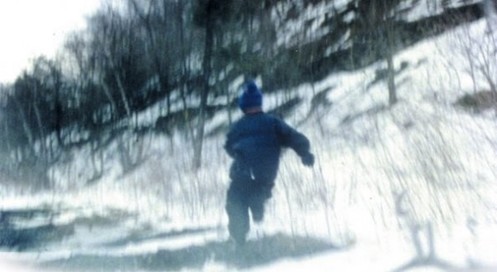 Larry Fessenden's Wendigo is shining example of effective low-budget filmmaking, a film which relies heavily on mood and ambiguity to create a sense of foreboding menace. Never relying on cheap thrills or shock horror to tell its quietly, brooding tale, Wendigo is a film where atmosphere and ingenuity are at a premium, effectively covering up the film's shoe-string budget due to the sense of foreboding doom the film is able to create. The story itself is one of George, a high-strung Manhattan urbanite, who along with his family has decided to head to upstate New York in an attempt to find some peace and quiet. On the way to their secluded cabin, George accidentally strikes and severely injures a deer, leading to a less than ideal encounter with a group of locals. Otis, one of these local men, is beyond furious at George, exclaiming that they've been tracking this deer for sometime. A verbal confrontation breaks out, luckily never escalating beyond words, but there is no question that the bizarre, hostile encounter has left not only George, but also his son, Miles shaken by the contentious encounter. From this point on, the family begins to find themselves haunted by some form of dark, mysterious presence, with Fessenden continually blurring the lines between reality and fantasy, making it impossible to tell if the threat to the families' safety lies mostly in the supernatural, or very much in reality, with the contentious local Otis. In Wendigo, Fessenden's narrative oscillates between its yuppie thriller narrative-the urbanite fish out of water tale, and its supernatural story-the spirit of the Wendigo, yet for most of the running time it remains unclear how much, if any of this, is psychological these characters, specifically the young boy who may be seeing things due to the trauma manifesting from the earlier confrontation between this father and Otis. Nothing is particularly clear in this way, and that's the way which Fessenden likes it, creating an atmospheric horror film in which the young son Miles provides the primary point of view. Larry Fessenden practically invented the book on effective, low-budget horror filmmaking, a filmmaker that routinely uses ingenuity, creativity, and effective use of camera movements, editing, and sound design to create an experience. In Wendigo, Fessenden uses an unsettling mix of time-lapse photography, quick-twitching montage, and slow-crawling photography, to create an atmosphere of menace, with the film's ambiguity adding an extra layer of unease. Thematically, Wendigo plays with this idea of the old vs. the new, touching on the intellectually imperialistic nature of modern thought where spirit and supernatural are viewed as simply fodder, something which is brushed off as creative imagination. The film juxtaposes this theme with the conflicting forces of urban and rural individuals, a film that itself remains vague as to what exactly transpired in its running time. A shining example of effective, low-budget storytelling, Larry Fessenden's Wendigo is a brooding, horror experience, a film which provides absolutely no cheap, shock horror, instead focusing on creating an effective atmosphere of brooding suspense.
0 Comments
Leave a Reply. |
AuthorLove of all things cinema brought me here. Archives
June 2023
|



 RSS Feed
RSS Feed
